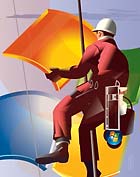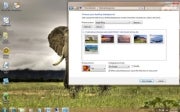Top 20 Windows 7 Tips
Here are 20 tricks to tweak Windows 7 into the interface that works best for you.
Preston Gralla, Computerworld
Nov 12, 2009 3:01 am
 Illustration: John Mattos Just got your hands on Windows 7
and want to bend it to your will? No problem. We've got plenty of tips,
hacks and secrets to keep you busy for a long time, including
automatically opening Windows Explorer to a folder of your choice,
speeding up taskbar thumbnails, finding hidden desktop themes, forcing
User Account Control to act the way you'd like, keeping your Explorer
searches secret from others, and more.
So check out these tips. If you like them, we'll keep more coming.
Also see the Gallery of the Best Windows 7 Tweaks.
General tips
We'll
start with a few nifty tips that can make your desktop more
interesting, make it easier to get around and increase your computer's
power efficiency.
Use Hidden International Wallpapers and Themes
When
you first install Windows 7, it asks for your language, time and
currency. Based on your responses, it installs a set of wallpapers and
themes. If you choose English (United States) for your time and
currency format, for example, the available desktop backgrounds and
themes will include a United States section with scenery from locations
such as Maine, the Southwest and so on.
Hidden, though, are
background scenery and themes from other English-speaking countries --
Australia, Canada, Great Britain and South Africa. Normally, you can't
access those backgrounds or themes, but there is a simple way you can
install and use them:
1. In the search box in the Start menu, type C:\Windows\Globalization\MCT and press Enter. (Note: If Windows 7 is installed in a drive other than C:, use that letter instead.)
2. Windows Explorer will launch and show you a list of subfolders under C:\Windows\Globalization\MCT:
MCT-AU, MCT-CA, MCT-GB, MCT-US, and MCT-ZA. Each subfolder has
wallpapers for a specific country: AU for Australia, CA for Canada, GB
for Great Britain, US for the United States, and ZA for South Africa.
For any of the countries whose wallpaper and themes you want to use, go into its Theme folder, for example, C:\Windows\Globalization\MCT\MCT-ZA\Theme. Double-click the theme you see there (for example ZA).
 A South Africa theme, ready to use.
Click to view larger image.
3. That will install a shortcut to the theme and wallpapers in the Personalization section of Control Panel.
You
can now use them as you would any other theme or background, by
right-clicking the desktop, choosing Personalize, and choosing a
background or theme. They will be listed in their own section.
Shake Your Desktop Free of Clutter
If
you frequently run multiple programs simultaneously, your desktop can
get extremely cluttered. This can get annoying if you're working on one
program and want to minimize all the other windows -- in previous
versions of Windows you had to minimize them individually.
With
Windows 7's "shake" feature, though, you can minimize every window
except the one in which you're currently working -- in a single step.
Click and hold the title bar of the window you want to keep on the
desktop; while still holding the title bar, shake it quickly back and
forth until all of the other windows minimize to the taskbar. Then let
go. To make them return, shake the title bar again.
You can
accomplish the same thing by pressing the Window key-Home key
combination -- although doing that is not nearly as much fun.
Get a Power Efficiency Report
Have
a laptop and want to get more battery life out of it? Windows 7
includes a hidden built-in tool that will examine your laptop's energy
use and make recommendations on how to improve it. To use it:
1. Run a command prompt as an administrator. To do this, type cmd in the search box, and when the cmd icon appears, right-click it and choose "Run as administrator."
2. At the command line, type in the following:
powercfg -energy -output \Folder\Energy_Report.html
where \Folder represents the folder where you want the report to be placed.
3.
For about a minute, Windows 7 will examine the behavior of your laptop.
It will then analyze it and create a report in HTML format in the
folder you specified. Double-click the file, and you'll get a report --
follow its recommendations for ways to improve power performance.
|